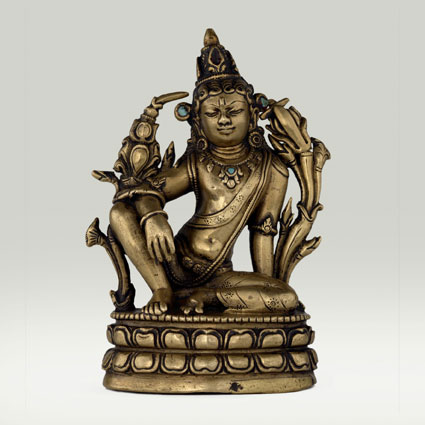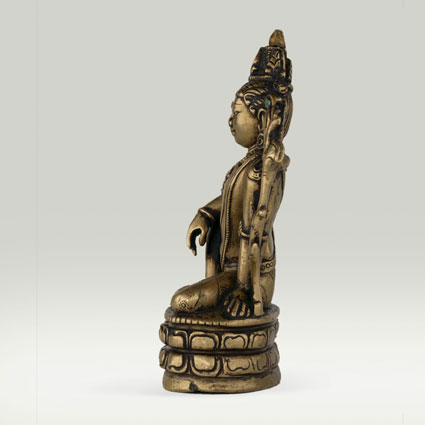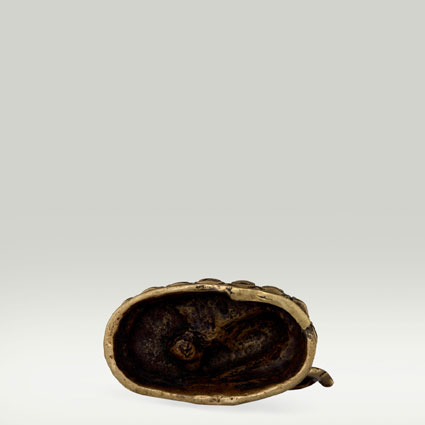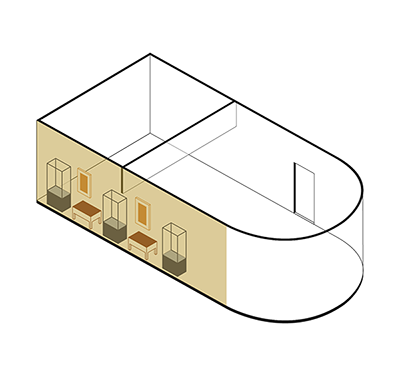ABS 069
Code: ABS 069
Country: Tibet
Style:
Date: 1250 - 1350
Dimensions in cm WxHxD: 7.1 x 12.2 x 4.1
Materials: Brass; decorated with dotted and linear design
Hollow cast in one piece.
The garments are decorated with dotted and linear design.
The ornaments are inset with three pieces of turquoise.
The bottom of the image is not sealed.
The Manjusri (Tib. 'Jam dpal) is seated in the attitude of royal ease (rajalilasana) on a double pedestal. He leans on the left arm placed on the pedestal and rest the right arm on the right leg. The Bodhisattva is clad with cloth (dhoti) tied around his waist with a decorated belt, and wears a shawl carried over the left shoulder and tied across the chest. He is bedecked with attached pendants, the "investiture with the beaded sacred threds" (ratnopavita), and one pair of bracelets at the upper arms and wrists.
Salks of blue lilies (nilotpala) are growing up on both sides of Manjusri. the flower on the proper left side by a manuscript (pustaka). The sword and the manuscript are the classical attributes of Manjusri.
(From Wikipedia, the free encyclopedia)
Manjushree, also written Manjushri, is the bodhisattva of keen awareness in Buddhism. A disciple of the historical Buddha Shakyamuni, he represents wisdom, intelligence and realisation, and is one of the most popular Bodhisattvas following Avalokitesvara (Ch: Guan Yin).
Together with Shakyamuni and fellow disciple Samantabhadra he forms the Shakyamuni trinity (Jp: Sanzon Shaka). Manjusri is one of the Eight Wisdom Bodhisattvas and one of the Japanese Thirteen Buddhas. In Tibetan Buddhism he sometimes is depicted in a trinity with Avalokiteshvara and Vajrapani.
Manjusri is mentioned in many Mahayana sutras, particularly the Prajnaparamita Sutras. The Lotus Sutra assigns him a paradise called Vimala, which according to the Avatamsaka Sutra is located in the east. His consort in some traditions is Saraswati. He is also sometimes called Manjughosha.
Within Tibetan Buddhism, Manjushri is a tantric meditational deity or Yidam, and considered a fully enlightened Buddha.
Manjusri Mantra
Chanting the Manjusri Mantra "Om Ah Ra Pa Tsa Na Dhih" is believed to enhance wisdom and improve one's skills in debating, memory, writing, explaining etc. "Dhih" is the seed syllable of the mantra and is chanted with greater emphasis.
A male Bodhisattva, he is depicted wielding a flaming sword in his right hand, representing his realisation of wisdom which cuts through ignorance and wrong views. The scripture supported by the flower held in his left hand is the Prajnaparamita, representing his attainment of ultimate realisation and Enlightenment. Variations upon his traditional form as Manjusri include Guhya-Manjusri, Guhya-Manjuvajra, and Manjuswari, most of which are Tantric forms associated with Tibetan Buddhism. The two former appearances are generally accompanied by a shakti deity embracing the main figure, symbolising union of form and spirit, matter and energy.
Manchu
According to legend Nurhaci, a military leader of the Jurchen tribes and founder of what became the Chinese imperial Qing Dynasty, believed himself to be a reincarnation of Manjusri. He therefore is said to have renamed his tribe the Manchu.
Yamantaka
Yamantaka (meaning “terminator of Yama i.e. Death”) is seen as a wrathful manifestation of Manjushri, the buddha of wisdom. Yamāntaka (Tibetan: Shinjeshe Wylie: Gshin-rje-gshed) is a Mahayana Buddhist yidam or iṣṭadevata of the Highest Yoga Tantra class in Vajrayana, popular within the Geluk school of Tibetan Buddhism.
Role in Nepalese Mythology
According to Swayambhu Purana, the Kathmandu Valley was once a lake. It is believed that Manjushri saw a lotus flower in the center of the lake and cut a gorge at Chovar to allow the lake to drain. The place where the lotus flower settled became Swayambhunath Stupa and the valley thus became habitable.
The Newars of the Kathmandu Valley, who adhere to both Buddhism and Hinduism, revere him as the Bodhisattva of Wisdom.
Bock, Etienne; Falcombello, Jean-Marc; Jenny Magali, 2022. Trésors du Tibet. Sur les pas de Milarépa.. Paris: Flammarion. p. 94
de Mallmann, Marie-Thérèse, 1964. Étude iconographique sur Manjusri. Paris: École Française d’Extrème-Orient. References to the iconography of Manjusri
de Mallmann, Marie-Thérèse, 1975. Introduction à l'iconographie du tântrisme bouddhique. Paris: Adrien Mainsonneuve (Jean Maisonneuve successeur (1970). P. 250-257 - References to the iconography of Manjusri
Sèngué, Tcheuky, 2002. Petite Encyclopédie des Divinités et symboles du Bouddhisme Tibétain. Editions Claire Lumiere . Pp. 164 / 185-191 - Références françaises: Manjushri






